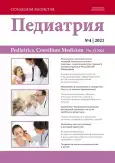Nutritional status analysis in preterm infants on different types of feeding
- Authors: Ovchinnikova T.V.1,2, Taranushenko T.E.1, Salmina A.B.1,3, Karpova L.N.1,2, Antsiferova E.V.1,2
-
Affiliations:
- Voino-Yasenetsky Krasnoyarsk State Medical University
- Krasnoyarsk Regional Clinical Center for Maternity and Childhood Protection
- Research Center of Neurology
- Issue: No 4 (2021)
- Pages: 323-329
- Section: Articles
- URL: https://pediatria.orscience.ru/2658-6630/article/view/100630
- DOI: https://doi.org/10.26442/26586630.2021.4.201338
- ID: 100630
Cite item
Full Text
Abstract
Breathing newborns born prematurely is a challenging task of modern perinatology. One of the main factors determining the normal growth and development of newborns (especially premature babies) is adequate nutrition. Assessment of nutritional adequacy includes anthropometry data in the dynamics, analysis of nutritional tolerance and, when indicated, a set of laboratory tests, of which the most important are clinical laboratory results (hemoglobin and traditional parameters of erythrocyte evaluation) and biochemical parameters characterizing protein metabolism (including indirect method of assessment of visceral protein reserves by urea level), iron supply, vitamin status, etc. Data on the nutritional status of premature infants in the period of newborn feeding are very scarce and controversial in the modern scientific literature, which determines the need for further studies on this problem.
Aim. To study the parameters of nutritional status (hemoglobin, total protein, albumin, creatinine, urea, plasma glucose) at birth, in dynamics on 10, 20, 30 days of life in the preterm infants with very low (VLBW) and low body weight (LBW) at birth on different types of feeding (breast milk – GM, GM in combination with fortificator and artificial nutrition – AI) to assess measures of feeding success and quality of nursing.
Materials and methods. The study of 118 infants aged from birth to 1 month of life in the Department of Pathology of Newborn and Premature Babies, Krasnoyarsk Regional Perinatal Center of Maternal and Child Health Protection. Group 1 consisted of 50 infants with OMT at birth, of whom 3 subgroups were formed depending on the type of feeding: breastfed (HB) – 17 infants, "enriched" GM (HB + fortificator) – 17 children, IV feeding - 16 children; Group 2 consisted of 68 children with OMT at birth, of whom 36 were on HB, 12 were on HB + fortificator, 20 were on IV.
Results. Assessment of the nutritional status of neonates with NFMT during IM revealed specific features in the development of early anemia of prematurity (10% of cases), high values of total protein in children by the end of the observation period in combination with increasing urea at all stages of observation and a higher creatinine level on day 20 of life. The incidence of early anemia of prematurity was comparable between the subgroups on different types of feeding and lower levels of total protein, albumin, and urea in the subgroup of children receiving HF + fortificator were obtained in the group of neonates with NMT.
Full Text
About the authors
Tatyana V. Ovchinnikova
Voino-Yasenetsky Krasnoyarsk State Medical University; Krasnoyarsk Regional Clinical Center for Maternity and Childhood Protection
Author for correspondence.
Email: tane4ka092009@rambler.ru
ORCID iD: 0000-0002-9319-2894
Graduate Student
Russian Federation, KrasnoyarskTatiana E. Taranushenko
Voino-Yasenetsky Krasnoyarsk State Medical University
Email: tetar@rambler.ru
ORCID iD: 0000-0003-2500-8001
D. Sci. (Med.), Prof.
Russian Federation, KrasnoyarskAlla B. Salmina
Voino-Yasenetsky Krasnoyarsk State Medical University; Research Center of Neurology
Email: allasalmina@mail.ru
D. Sci. (Med.), Prof.
Russian Federation, Krasnoyarsk; MoscowLyudmila N. Karpova
Voino-Yasenetsky Krasnoyarsk State Medical University; Krasnoyarsk Regional Clinical Center for Maternity and Childhood Protection
Email: tane4ka092009@rambler.ru
Cand. Sci. (Med.)
Russian Federation, KrasnoyarskEkaterina V. Antsiferova
Voino-Yasenetsky Krasnoyarsk State Medical University; Krasnoyarsk Regional Clinical Center for Maternity and Childhood Protection
Email: Anciferova_ekate@mail.com
Cand. Sci. (Med.)
Russian Federation, KrasnoyarskReferences
- Roszkowska R, Taranta-Janusz K, Wasilewska A. The role of early-life metabolic programming in the pathogenesis of lifestyle diseases. Dev Period Med. 2014;18(4):477-82.
- Lapillonne A, Griffin IJ. Feeding preterm infants today for later metabolic and cardiovascular outcomes. J Pediatr. 2013;162(3 Suppl.):S7-16. doi: 10.1016/j.jpeds.2012.11.048
- Bagheri F, Nakhaee N, Jahani Y, Khajouei R. Assessing parents' awareness about children's "first thousand days of life": a descriptive and analytical study. Arch Public Health. 2021;79(1):154. doi: 10.1186/s13690-021-00673-6
- Nordman H, Jääskeläinen J, Voutilainen R. Birth Size as a Determinant of Cardiometabolic Risk Factors in Children. Horm Res Paediatr. 2020;93(3):144-53. doi: 10.1159/000509932
- Schneider N, Garcia-Rodenas CL. Early Nutritional Interventions for Brain and Cognitive Development in Preterm Infants: A Review of the Literature. Nutrients. 2017;9(3):187. doi: 10.3390/nu9030187
- Kim YJ, Shin SH, Lee ES, et al. Impact of size at birth and postnatal growth on metabolic and neurocognitive outcomes in prematurely born school-age children. Sci Rep. 2021;11(1):6836. doi: 10.1038/s41598-021-86292-1
- Ramel SE, Zhang L, Misra S, et al. Do anthropometric measures accurately reflect body composition in preterm infants? Pediatr Obes. 2017;12(Suppl. 1):72-7. doi: 10.1111/ijpo.12181
- Bradford J, Beck K, Nshimyiryo A, et al. Nutritional evaluation and growth of infants in a Rwandan neonatal follow-up clinic. Matern Child Nutr. 2020;16(4):e13026. doi: 10.1111/mcn.13026
- Программа оптимизации вскармливания детей первого года жизни в Российской Федерации. М., 2019 [Programma optimizatsii vskarmlivaniia detei pervogo goda zhizni v Rossiiskoi Federatsii. Moscow, 2019 (in Russian)].
- Pereira-da-Silva L, Virella D, Fusch C. Nutritional Assessment in Preterm Infants: A Practical Approach in the NICU. Nutrients. 2019;11(9):1999. doi: 10.3390/nu11091999
- Chmielewska A, Farooqi A, Domellöf M, Ohlund I. Lean Tissue Deficit in Preterm Infants Persists up to 4 Months of Age: Results from a Swedish Longitudinal Study. Neonatology. 2020;117(1):80-7. doi: 10.1159/000503292
Supplementary files








